Input interpretation

bromotrichloromethane
Chemical names and formulas
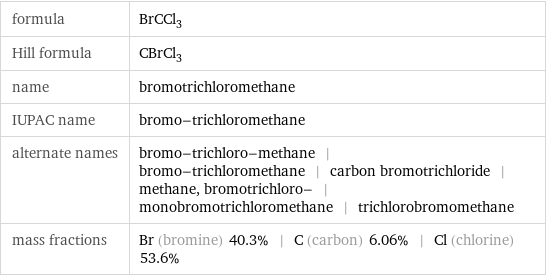
formula | BrCCl_3 Hill formula | CBrCl_3 name | bromotrichloromethane IUPAC name | bromo-trichloromethane alternate names | bromo-trichloro-methane | bromo-trichloromethane | carbon bromotrichloride | methane, bromotrichloro- | monobromotrichloromethane | trichlorobromomethane mass fractions | Br (bromine) 40.3% | C (carbon) 6.06% | Cl (chlorine) 53.6%
Lewis structure
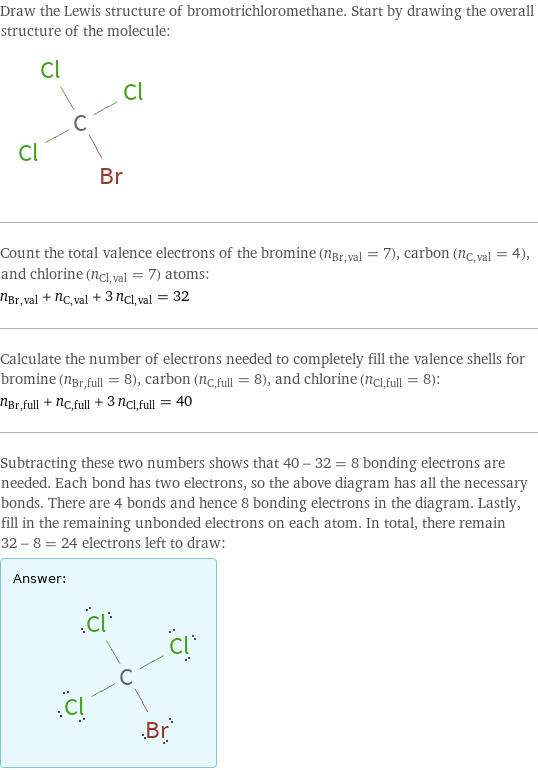
Draw the Lewis structure of bromotrichloromethane. Start by drawing the overall structure of the molecule: Count the total valence electrons of the bromine (n_Br, val = 7), carbon (n_C, val = 4), and chlorine (n_Cl, val = 7) atoms: n_Br, val + n_C, val + 3 n_Cl, val = 32 Calculate the number of electrons needed to completely fill the valence shells for bromine (n_Br, full = 8), carbon (n_C, full = 8), and chlorine (n_Cl, full = 8): n_Br, full + n_C, full + 3 n_Cl, full = 40 Subtracting these two numbers shows that 40 - 32 = 8 bonding electrons are needed. Each bond has two electrons, so the above diagram has all the necessary bonds. There are 4 bonds and hence 8 bonding electrons in the diagram. Lastly, fill in the remaining unbonded electrons on each atom. In total, there remain 32 - 8 = 24 electrons left to draw: Answer: | |
3D structure

3D structure
Basic properties
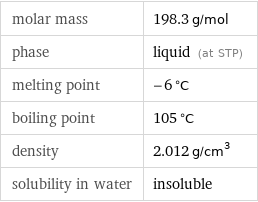
molar mass | 198.3 g/mol phase | liquid (at STP) melting point | -6 °C boiling point | 105 °C density | 2.012 g/cm^3 solubility in water | insoluble
Units

Liquid properties (at STP)
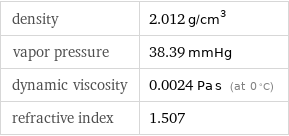
density | 2.012 g/cm^3 vapor pressure | 38.39 mmHg dynamic viscosity | 0.0024 Pa s (at 0 °C) refractive index | 1.507
Units

Thermodynamic properties
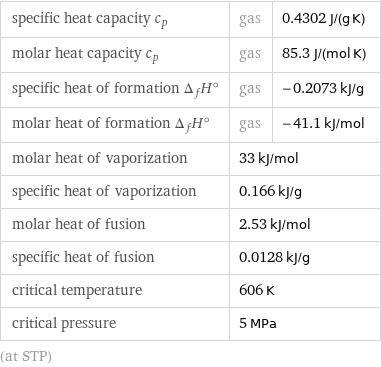
specific heat capacity c_p | gas | 0.4302 J/(g K) molar heat capacity c_p | gas | 85.3 J/(mol K) specific heat of formation Δ_fH° | gas | -0.2073 kJ/g molar heat of formation Δ_fH° | gas | -41.1 kJ/mol molar heat of vaporization | 33 kJ/mol | specific heat of vaporization | 0.166 kJ/g | molar heat of fusion | 2.53 kJ/mol | specific heat of fusion | 0.0128 kJ/g | critical temperature | 606 K | critical pressure | 5 MPa | (at STP)
Chemical identifiers
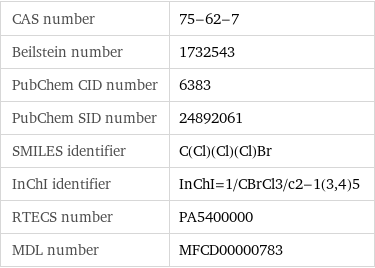
CAS number | 75-62-7 Beilstein number | 1732543 PubChem CID number | 6383 PubChem SID number | 24892061 SMILES identifier | C(Cl)(Cl)(Cl)Br InChI identifier | InChI=1/CBrCl3/c2-1(3, 4)5 RTECS number | PA5400000 MDL number | MFCD00000783
NFPA label

NFPA label

NFPA health rating | 2 NFPA fire rating | 0 NFPA reactivity rating | 0
Safety properties

flash point | 19 °C

DOT hazard class | 6.1 DOT numbers | 2810
Toxicity properties

RTECS classes | mutagen | human data